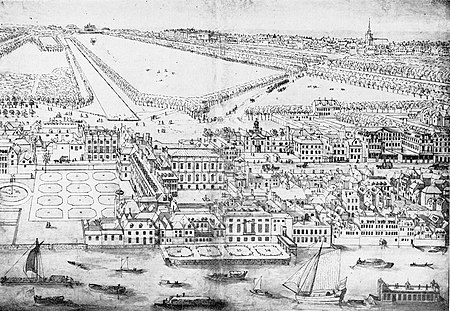Privy Garden of the Palace of Whitehall

The Privy Garden of the Palace of Whitehall was a large enclosed space in Westminster, London, that was originally a pleasure garden used by the late Tudor and Stuart monarchs of England. It was created under Henry VIII and was expanded and improved under his successors, but lost its royal patronage after the Palace of Whitehall was almost totally destroyed by fire in 1698. From the start of the 18th century onwards, the garden went through major changes as it fell into neglect. It was painted in 1747 by Canaletto during a period of transition, as Westminster was being transformed by the construction of new buildings and roads. By the start of the 19th century it had been redeveloped as the site for a row of townhouses, some of which were occupied by prime ministers seeking homes near the government buildings nearby. The last remnants of the Privy Garden were destroyed in 1938 during the construction of government offices which now house the Ministry of Defence's headquarters building.
Excerpt from the Wikipedia article Privy Garden of the Palace of Whitehall (License: CC BY-SA 3.0, Authors, Images).Privy Garden of the Palace of Whitehall
Horse Guards Avenue, City of Westminster Lambeth
Geographical coordinates (GPS) Address Website Nearby Places Show on map
Geographical coordinates (GPS)
| Latitude | Longitude |
|---|---|
| N 51.503841 ° | E -0.124894 ° |
Address
Ministry of Defence
Horse Guards Avenue
SW1A 2HB City of Westminster, Lambeth
England, United Kingdom
Open on Google Maps











